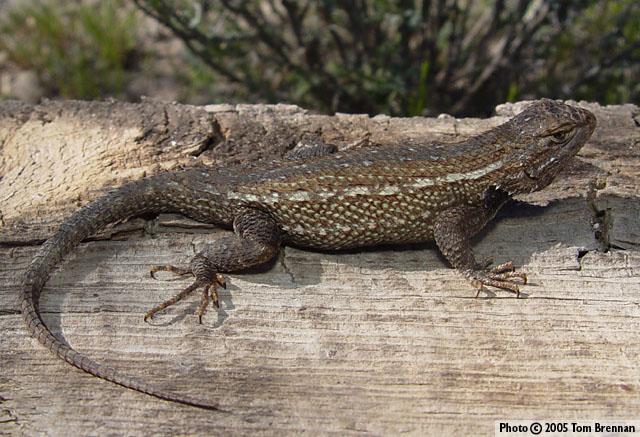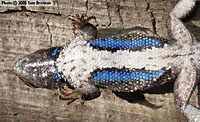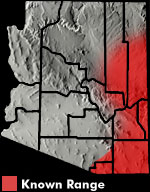Online Field Guide to The Reptiles and Amphibians of Arizona



Cochise County, AZ
 Cochise Co., AZ |
| SOUTHWESTERN FENCE LIZARD Sceloporus cowlesi | |
|
DESCRIPTION: A small (up to 76 mm or 3″ from snout to vent), gray-brown to golden-brown lizard with pointed, keeled, overlapping scales and two light stripes on the back. The mid-dorsum is marked with a broad, gray stripe. Some specimens have small, dark blotches on the back between the stripes. Males have two large, bright blue patches on the belly. The belly patches are usually edged with dark gray or black. The underside of the throat is marked with two blue blotches, one on each side. The shoulder area is often dark gray. Belly patches are faint or lacking in females. Gravid females often have an orange or yellow tint on the back. The paired throat blotches distinguish this lizard from the similar looking Common Sagebrush Lizard. Its lack of side blotches distinguishes it from the Common Side-blotched Lizard. Belly patches (in males) distinguish it from the Striped Plateau Lizard which has a plain belly. The scales on the sides of the body are arranged in diagonal rows (spines point up and back) distinguishing this lizard from Slevin’s Bunchgrass Lizard. The Southwestern Fence Lizard is nearly identical to the Plateau Lizard in appearance but the two are genetically distinct from one another. DISTRIBUTION: This lizard ranges across most of southeastern Arizona and portions of east-central Arizona. Its boundary with the similar Plateau Lizard is poorly known. In Arizona the Southwestern Fence Lizard is found at elevations ranging from about 3,000′ to 9,000′. HABITAT: A variety of biotic communities are home to this lizard. In southeastern Arizona it is found in Chihuahuan Desertscrub, Semidesert Grassland, and Madrean Evergreen Woodland. In northern Arizona it occurs in Great Basin Desertscrub, Plains and Great Basin Grassland, woodlands, and Petran Montane Conifer Forest. In southeastern Arizona it is usually encountered in low valleys, grassy plains, bajadas, and foothills. In northern Arizona it inhabits a wider variety of habitats ranging from low valleys and plains into steep mountainous terrain such as rocky canyons and forested slopes. It is usually encountered in relatively open, sunlit areas with plenty of basking sites such as rock piles, wood piles, and fallen logs. BEHAVIOR: During the summer this diurnal lizard is most active mid morning and late afternoon. In spring and fall it can be active all day long. It forages on the ground but climbs onto rocks, trees, fence posts, and wood piles to bask. It hibernates during the cold months of winter and late fall. DIET: The Southwestern Fence Lizard sits and waits for prey to wander within close proximity. It feeds on a variety of insects including termites, ants, beetles, grasshoppers, flies, larvae, and wasps. It also eats a variety of spiders, snails, and small lizards. REPRODUCTION: Mating begins in spring and continues into early summer. One to 4 clutches of eggs are laid in late spring and summer. Clutch size ranges from 1 to 10 eggs. Hatchlings begin to emerge in June and continue to emerge through September. By Thomas C. Brennan Brennan, T. C., & A. T. Holycross. 2006. A Field Guide to Amphibians and Reptiles in Arizona. Arizona Game and Fish Department. Phoenix, AZ Degenhardt, W. G., Painter, C. W., and Price, A. H.. 1996. Amphibians and Reptiles of New Mexico. University of New Mexico Press. Albuquerque. Leaché and Reeder 2002 Molecular Systematics of the Eastern Fence Lizard (Sceloporus undulatus): A Comparison of Parsimony, Likelihood, and Bayesian approaches. Systematic Biology. 51: 4468 Stebbins, R.C. 2003. A Field Guide to Western Reptiles and Amphibians, Third Edition. Houghton Mifflin Company, Boston, MA. |
|
Visit Partners in Amphibian and Reptile Conservation:


HOME
Copyright © 2023, Arizona Game and Fish Department. All rights reserved.
If you make use of the textual contents of this site in reports, publications, etc. please cite and credit the author(s) and photographer(s). All photos on this website are copyrighted. However, those found in the species account section may be used for any noncommercial scientific, educational, or conservation purposes provided that photographs are not altered and continue to bear the copyright symbol and name of the photographer. Please contact the photographer regarding commercial use of copyrighted photographs.










